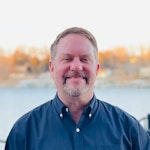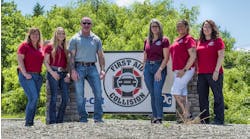Family-owned Schaefer Autobody Centers pauses expansions to bolster internal processes
With its recent pace of expansions, one might have expected regional MSO Schaefer Autobody Centers to add another location by the end of 2019. After all, between 2014 and 2018, the company had added three new shops, including one in Columbia, Mo., expanding its footprint to 11 locations. The company serves mostly a customer base in the St. Louis metro area — with a population of about three million — and was founded in 1985 by Steve Schaefer in the St. Louis suburb of Webster Groves.
But rather than push outward in 2019, Schaefer’s son, President/Owner Scott Schaefer, decided to prepare for future growth by focusing inward on the company’s internal core processes. He led the company in redefining job roles, continuing to adapt to vehicle technology, and bolstering its training to prepare for future growth.
“We’ve been focusing on developing and training our leadership team, our managers, and our technicians, and focusing on strengthening our processes and operations before we pursue more growth,” he says. “I expect that we are now already at a point where we can handle more expansion.”
Facility expands for training center addition
Planning for this change, beginning in late 2018 Schaefer nearly doubled the size of its Creve Coeur facility, which is almost 70,000 square feet with the acquisition of adjacent space previously leased to a storage company. 15,000 square feet of that is devoted to the company’s training department. Two full-time trainers are joined by two employees who work part-time in auditing processes, while one of the operations managers, who oversees five locations, was previously the training manager. The expansion also accommodates in-house training to complement I-CAR and various training required for OEM-certification programs. Schaefer Auto Body Centers is currently certified under Subaru, Chrysler, Ford, GM, Honda/Acura, and Nissan/Infiniti. Schaefer says the company is in the final stages of becoming BMW-certified at two of its locations. One of those locations was already a BMW dealer-owned shop that Schaefer acquired.
“It’s just part of building that healthy foundation so that when the opportunity presents itself for us to scale out, we have our core processes dialed in and followed. We have a strong bench of talent we can move into nearby locations, and it just gives us a more repeatable, scalable business model.”
SOS answers the call for ADAS calibration
About six months ago, Schaefer formed SOS Auto Glass and Calibrations, marketed as SOS Auto Glass for short. The “SOS” stands for “Schaefer Optimal Solutions,” the winner of a naming contest among employees. The distinct name for the new division avoids the optics of having a Schaefer-branded service vehicle on another shop’s lot. Last year, SOS, which now has a staff of three, performed only in-house glass work and calibrations that were related to the collision repair process.
“In 2020, we are now working with customers outside of our company, including dealerships and insurance referral work,” Schaefer says.
The 20,000-square-foot calibration center at the Creve Coeur facility provides ample room for static calibrations. The equipment used is a mixture of OEM and aftermarket scan tools and OEM targets, and SOS is currently trained and tooled-up to serve the most popular 80 percent of the vehicle population, or 90 percent of the vehicles the company sees for repair work.
“We’ve had to create awareness and offer training to our estimators and managers at our stores,” Schaefer says. “There are different definitions for different types of calibrations. Even though they’re very similar, they might use different language to describe them. And it’s important you keep that fairly consistent. We communicate back-and-forth between calibrations, because they have to know what was done to the car, what needs to be done, and what needs to be checked, in order to ensure they’re doing a full and complete calibration on every vehicle.”
Schaefer said the company is in the beginning phase of offering its calibration center service to body shops outside of the company.
“I expect this to gradually increase throughout the year as we hire and train more staff to operate the calibration center,” he says. “We want to make sure that we are offering the best service to our customers and not taking on too much business before we have the capacity to handle it. With ADAS and AEB [automatic emergency braking] compliance increasing at such a fast pace, I anticipate the calibration center will become a much larger component of our overall business model as we continue to expand into new markets.”
Operational consistency and local touch can coexist
Schaefer Autobody Centers has long used a centralized call center at its corporate headquarters, which moved last year from Fenton, Mo., to its latest facility in south St. Louis County.
CCC ONE is the company’s main estimating platform, and it is also used to receive assignments, including at the call center. The other major estimating systems are used based on DRP and OEM certification compliance, Schaefer said, while Nexsyis Collision is the management system used. Call center representatives treat the initial call as a triage. During that call, the car’s repair needs can be assessed, including if it needs to go to one of the company’s OEM-certified facilities, including the aluminum repair center in Crestwood. Repair capacity of the company’s shops will also be assessed to see if load-leveling is appropriate.
The various shops are a combination of consistent core processes and unique personalities and capabilities.
“Our core processes, for the most part, are consistent location to location, and that’s important to ensure customer satisfaction, quality of repair, and adherence and compliance to specific guidelines that we have to follow,” Schaefer says. “The more consistent you can be from store to store, the easier it is to manage that and scale it out. But you don’t want it to be so cookie cutter that the store loses its personality or what makes it special and successful in its location.”
Variables include different dealership relationships and shop sizes.
“You’ve got to be flexible and be able to kind of manage the differences between those stores, as long as they don’t detract from the overall performance. But just like how each municipality has unique things about it, each store’s going to have unique things about it that cause it to operate just a little bit differently. It could be the demographics of the population, what types of vehicles are most popular, or what key accounts that location has.
“Some shops have accounts that get a lot of lighter work referred to them, and so some of their processes and the way the shop’s laid out are a little different than some of the shops that have more hard-hit, higher severity work. We’re able to put the right people in the right seats at that location who work really well with that community.”
Acquire a competitor or break ground?
In looking for expansion possibilities, Schaefer said the company has employed a mixture of greenfield construction and acquisitions, and he expects that to continue in the future. Shops that are attractive to Schaefer for possible acquisition have a desirable location, updated equipment, and a solid foundation of trained employees. But those opportunities are infrequent, he says.
“Acquisitions are certainly a much faster way to break even than a greenfield is. Although when we got Columbia up and running, that place did really well by the end of its first year; it was profitable and pretty successful. But you have to have a lot of things line up just right for that to happen. You have to be assured that you have a strong customer base: the market’s underserved, so there’s high demand; and if possible, you’d like to get some accounts set up, or at least some assurance that you’ll have accounts set up once you open a store.”
Without such assurances, it can take a lot longer for a store to break even or eventually become profitable, he notes.
Training for future technicians
The availability of talented technicians has gotten scarce, Schaefer says, so he’d like to develop qualified personnel in-house. His vision for 2020 is to make the training center fully functional and complete with its own paint, welding, and frame departments, so those operations can be taught outside of a production environment.
“There are a lot of people who show great aptitude, passion, and drive. But they just don’t have the training or the skills developed yet, and if we can offer that to them and keep them in the company and keep promoting them, I think that that’s a good, sustainable model. The demand only gets higher and higher each year, so at some point you have to take it upon yourself to put together a program and do it.”
Creating a winning culture
The best lessons are often hard-won, and Schaefer admits to placing too much emphasis in the past on strategy over company culture.
“Company culture eats strategy’s lunch every day of the week,” he says. “If you can build a culture of people who are motivated to win and succeed and believe in what the company does in their mission, it’s like any great sports team, you know? The team is really what has to come first. You can have the best coach in the world with the best game plan, but if the team culture isn’t there, the team that has the better culture is gonna win.”
Personality tests or culture indices can be useful tools, and Schaefer does employ them. But they can’t identify an applicant’s skill level or integrity.
“In the past, we’ve made the mistake of relying too much on those, and we’ve maybe overlooked how well the employee represented the company’s core values. When you hire somebody, you’re placing a bet — you don’t know how they’re going to work out. You have to do the best you can in the screening process and the interviewing process. But ultimately, you don’t know until they’ve been in the company long enough and you can see how they operate and how they affect the culture.”
Firing an employee who may be a high-productivity or revenue-producer, even one with a bad attitude, may seem counter-intuitive.
“But if you have the courage to do that, what you’ll often find is once they’re out of the picture, everybody else’s game improves. You start getting more out of everybody else, and people enjoy their work life more.”
Company-hosted family picnics, bowling nights, and outings to the go-cart track help foster relationships with people who work together or work at separate locations.
“But you have to make sure you have the right people in the right seats first. because if you don’t, then all that other stuff you do is kind of for nothing.”
It’s to what Schaefer attributes much of his success.
“Developing a culture of people who are passionate about what they do in the company is the best investment you can make, and it always pays you back."





